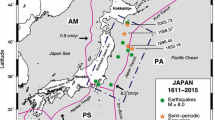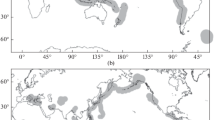Abstract
Among the schemes for earthquake forecasting, the search for semi-periodicity during large earthquakes in a given seismogenic region plays an important role. When considering earthquake forecasts based on semi-periodic sequence identification, the Bayesian formalism is a useful tool for: (1) assessing how well a given earthquake satisfies a previously made forecast; (2) re-evaluating the semi-periodic sequence probability; and (3) testing other prior estimations of the sequence probability. A comparison of Bayesian estimates with updated estimates of semi-periodic sequences that incorporate new data not used in the original estimates shows extremely good agreement, indicating that: (1) the probability that a semi-periodic sequence is not due to chance is an appropriate estimate for the prior sequence probability estimate; and (2) the Bayesian formalism does a very good job of estimating corrected semi-periodicity probabilities, using slightly less data than that used for updated estimates. The Bayesian approach is exemplified explicitly by its application to the Parkfield semi-periodic forecast, and results are given for its application to other forecasts in Japan and Venezuela.




Similar content being viewed by others
References
Bak, P., Tang, C., and Wiesenfeld, K. (1988) Self-organized criticality. Phys. Rev. A 38(1), 364–374.
Bak, P., and Tang, C. (1989) Earthquakes as a self-organized critical phenomenon. J. Geophys. Res. 94(B1), 15635–15637.
Bak, P., and Chen, K. (1991) Self-organized criticality. Sci. Am. 26–33.
Bakun, W., and Lindh A. (1985) The Parkfield, California earthquake prediction experiment. Science 229, 4714, 619–624.
Bracewell, R., The Fourier transform and its applications. (McGraw-Hill Book Co., USA, 381 pp., 1965).
Cox, A. (1973) Plate tectonics and geomagnetic reversals. (W. H. Freeman and Co.).
Daley, D., Vere-Jones, D. (2002) An introduction to the theory of point processes. Vol. I. Springer, USA, 469 pp.
Lomnitz, C. (1966) Statistical prediction of earthquakes. Reviews of Geophysics 4, 377–393.
Lomnitz, C., Fundamentals of earthquake prediction. (JohnWiley & 673 Sons Inc., USA, 326 pp. 1994).
Márquez, V. (2012) Multifractal analysis of the spatial distribution of seismicity and its possible prmonitory application. Exploration of a possible mechanism for fractality through semi-stochastic modeling. D.Sc. Thesis, CICESE, 31/08/2012 (in Spanish).
Morgan, W. (1968). Rises, trenches, great faults, and crustal blocks. J. Geophys. Res. 73(6), 1959–1982.
Nava, F., Quinteros, C., Glowacka, E., Frez, J. (2014) Semi-periodic sequences and extraneous events in earthquake forecasting: I. Theory and method, Parkfield. Pageoph 171(7), 1355–1366, doi:10.1007/s00024-013-0679-5.
Parzen, E. (1960) Modern probability theory and its applications. John Wiley & Sons, Inc., Japan, 464 pp.
Quinteros, C., Nava, F., Glowacka, E., Frez, J. (2014) Semi-periodic sequences and extraneous events in earthquake forecasting: II Application, forecasts for Japan and Venezuela. Pageoph 171(7), 1367–1383, doi:10.1007/s00024-013-0678-6.
Quinteros, C., Nava, F. (2013) Postnóstico (pronóstico hecho a posteriori) del sismo del 11 de octubre de 2013 en Venezuela, mediante análisis de semiperiodicidad. GEOS 33 (2), 350-355..
Reid, H. (1910) The mechanics of the earthquake, the California earthquake of April 18, 1906. Report of the State Investigation Commission, Vol. 2, Carnegie Institution of Washington, Washington, D.C.
Richter, C., Elementary Seismology, (W. H. Freeman and Co., USA, 768 pp. 1958).
Turcotte, D., Fractals and Chaos in Geology and Geophysics. (Cambridge University Press, Second edition, New York. 221 pp, 1992).
Winkler, R. An introduction to Bayesian inference and decision. 2nd Edition, (Probabilistic Publishing, USA, 452 pp. 2003).
Acknowledgments
Our sincere thanks to two anonymous reviewers and to Pageoph guest editor Matthew Gerstenberger. This project was partially funded by CONACYT scholarship 242919 (C. Quinteros) and CONACYT grant 222795, and was partially carried out within project CGL2011-29474-C01-01.
Author information
Authors and Affiliations
Corresponding author
Rights and permissions
About this article
Cite this article
Nava, F., Quinteros, C., Glowacka, E. et al. A Bayesian Assessment of Seismic Semi-Periodicity Forecasts. Pure Appl. Geophys. 173, 197–203 (2016). https://doi.org/10.1007/s00024-015-1056-3
Received:
Revised:
Accepted:
Published:
Issue Date:
DOI: https://doi.org/10.1007/s00024-015-1056-3




